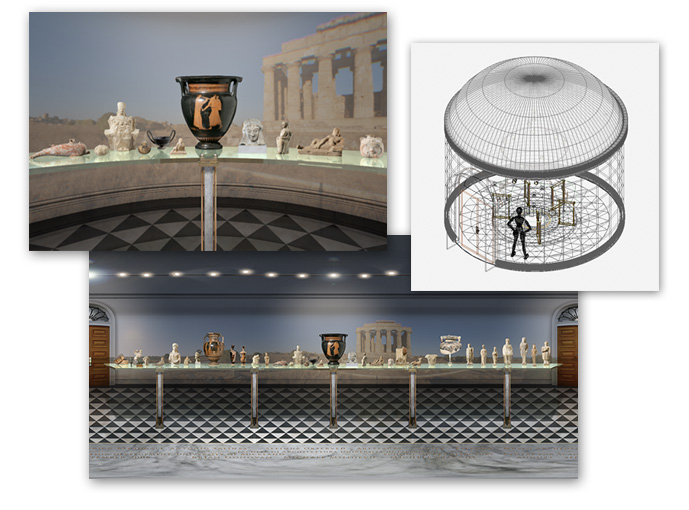3D modelling and animation. Used for creating 3D models from sets of photographs (photogrammetry) as well as for animating photographic imagery (see Image Animations), compositing 3D elements into photographs (often using image-based lighting - see below), and producing 3D imagery to enhance multimedia projects. A set of interactive 3D models of the five Platonic solids can be viewed on the Projections page.
Photogrammetry: generating a 3D model from photographs, as in the examples below of a replica of an ancient Greek sculpture, a Roman theatre mask, and a fossil trilobite.
See the 360° Objects section for a photographic object movie of this object.
See also the Other Imagery/slit-scan section for a 360° peripheral image.
Below, two objects also made using photogrammetry: the skulls of a cat (top) and a seal.


A 360° object movie made from photographs of the cat skull can be viewed in the 360° Objects section.
Above: a collection of scanned objects; click for a 360° panorama located inside the box. |
Above: a collection of old toys; click to to view an object movie. |
Below, two old books similarly modelled. Click for a larger version.
Model of an antique pot

Moon model
Above: Click to view a 24-second movie of the moon's phases over the course of a month. |
Above: Click to view an interactive 360° object movie of the moon. |
Albedo and elevation data from NASA.
Parthenon model: made as the basis for an interactive object 'movie' to display elements of the temple's surviving sculptural decoration - the pediment sculptures, the metopes and the frieze, rendered as photographic 'textures' superimposed on the the stylised architectural elements.

Herculaneum house plan model: one of a series of stylised, simplified, 'extruded' house plans (in this case, of the two-storey Casa a Graticcio) made for inclusion in the book Herculaneum Past and Future by Andrew Wallace-Hadrill.

Roman theatre model: a simplified, untextured model of a Roman theatre.

Image Based Lighting: Spherical photographic panoramas in 32-bit High Dynamic Range format can be used to light a 3D model or scene (in the examples below, a reflective sphere is included in the render to give a sense of the HDR light source). Moreover, very realistic images can be made where a 3D element has been rendered in this way, and then inserted into a photograph made under the same lighting conditions.
 |
 |
 |
 |
 |
 |
The composite images below contain a roughly 50/50 mix of real and 3D-modelled objects, the latter rendered using image-based lighting.
 |
 |
 |
 |
 |
 |
 |
Virtual museum gallery from Selinus Observed project. This rotunda model formed the basis for an interactive panorama of a virtual museum space, containing thirty-six artefacts which could be selected and examined in turn as ‘object movies’. At top: a typical view in rectilinear perspective; at right: a wireframe render seen from the ‘outside’; bottom: the entire interior rendered as a 360x180-degree equirectangular projection.

Berm tunnel with projections from Selinus Observed project. A still frame from the opening title sequence.

Through a looking glass: below, a still frame from one of a series of 3D-modelled animations made for a PhD candidate in Optometry studying neuropsychological development of young children. Used as part of a screen-based programme for testing two-year-olds.





